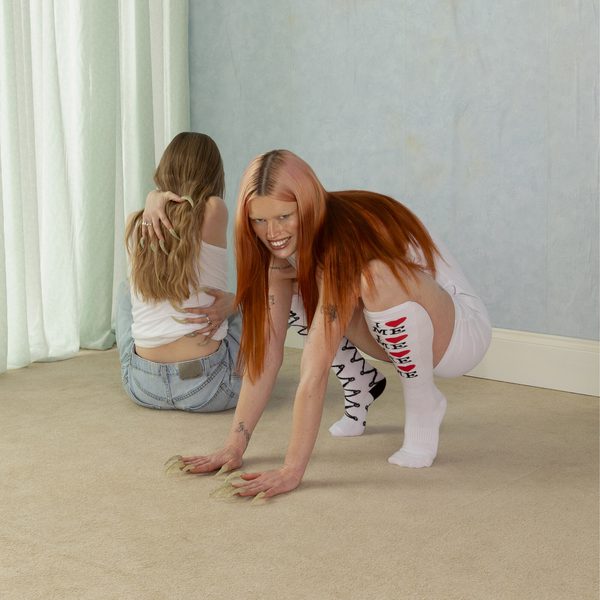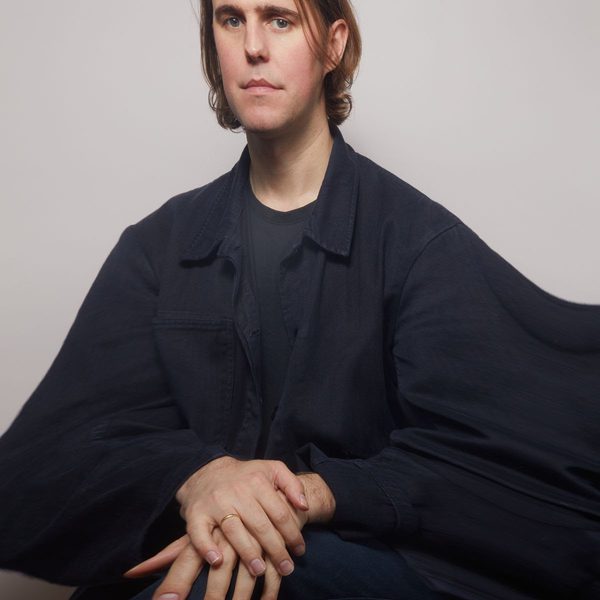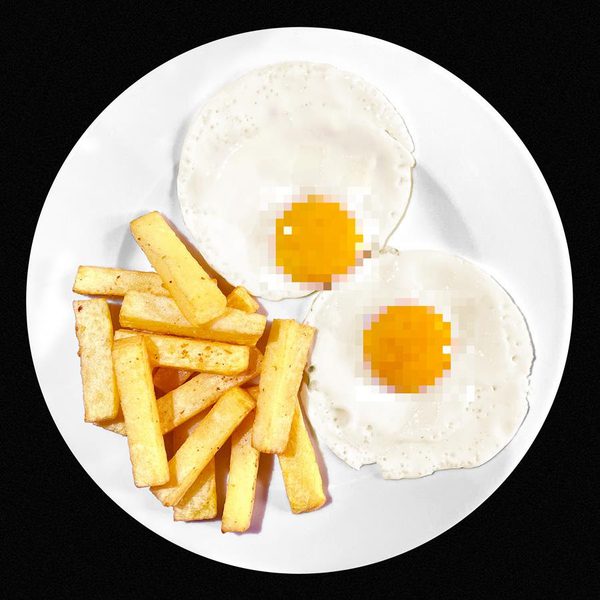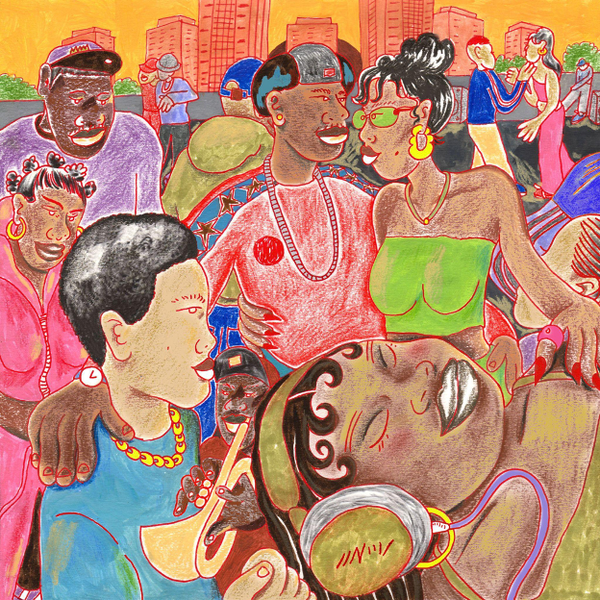
Following her starring role in Netflix's dark comedy Do Revenge and the release of her luminous second album Moss, Maya Hawke talks Sophie Walker through the song chapters of her ongoing coming-of-age story.
The facts of Maya Hawke’s birth are by far the least interesting thing about her.
The 24-year-old daughter of Uma Thurman and Ethan Hawke is an actor with chameleonic instinct, capable of channelling a certain charisma through a lens of vulnerability that belies her years.
She is Robin Buckley in Stranger Things, wry and whip-smart on the surface, but untangling the complexities of her sexuality beneath; she is ‘Flowerchild’, Linda Kasabian in Manson’s California in Tarantino’s Once Upon a Time in Hollywood; she is Jo March in Vanessa Caswill's Little Women, fiery and outspoken - and most recently, she is Eleanor Levetan, an inciter of chaos in the pastel-kissed world of Do Revenge. She is certainly more than a familiar surname.
Hawke’s mind whirrs at a pace that her words have no hope to match – though she is naturally observant, more prone to introspection and quiet pauses of thoughtfulness than her enthusiastic fizz would have you believe. Though the uninitiated may cynically assume that Hawke’s success was pre-ordained through pulled strings, the fact remains that this would soon fizzle were it not sustained by her talent. That, and a devotion to her craft; a sense of humility, of knowing that she is still, and always hopes to be, a student.
As Hawke’s career has gained momentum, she has become a figure of fascination – a ‘Someone’ with a capital S whose life, beyond her work, is deemed worthy of dissection. Reflecting on putting together her Nine Songs, she tells me, “I love doing this kind of thing. Any opportunity to talk about anything without having to talk too much about, like, ‘what you’re wearing’,” she laughs. “It’s nice to have these jumping off points that feel creative and connected to why you wanted to make art in the first place. It’s my privilege,” she adds, “So thank you.”
I catch Hawke at an interesting moment in her life. Everything is about to happen, and right now, she is standing on the edge of it all. Next year, Hawke is set to star in Bradley Cooper’s biographical film about Leonard Bernstein, Maestro, and Wes Anderson’s upcoming romantic dramedy, Asteroid City. “I’m in a beautiful moment of giving away a lot of hard work from the last two years of my life, and closing a chapter,” she tells me. “It’s so nice to give these things away to the world and share them.”
Among these gifts Hawke is leaving with us is her second record, Moss, following the release of her critically acclaimed 2020 debut, Blush. Many described Blush as a “coming-of-age record”, but that’s a chapter that Hawke still feels is being written. “We’re always coming of age to a new place until we die,” she observes. “We’re always changing and evolving. Moss is just as much a coming-of-age record – it’s just coming into a different moment.”
It feels apt, given Hawke’s gift for evocative imagery in her lyrics, that she would say: “You know when you’re playing tarot cards and you draw a death card, and tarot card readers say, ‘Don’t worry, it’s a great card?’ – well that’s how I feel about this record. It was a death card draw. It’s a good death, it’s a great death: a death that will lead to something new.”
Hawke assembled her Nine Songs choices based on retracing her steps. Each crystallises a moment in time from which there was no turning back; without these songs, we wouldn’t know the same person Hawke came to be. Her greatest enthusiasm, however, is reserved for an unexpected corner of music – one which she feels she could make a dozen playlists for, in itself: children’s music.
One of her earliest memories was listening to the likes of Woodie Guthrie’s Songs to Grow on for Mother and Child in the car. And when you listen to Hawke’s music now, that same luminosity, the finely-spun blend of rich, but simplistic language and sharp imagery, is common to both.
“The best children’s music is interesting to listen to, even as an adult, and that’s because it’s good storytelling,” she explains, having written her senior thesis in high school on the genre’s evolution. “It’s an interesting lesson in songwriting. The message is very clear, but if you go back and listen, there’s something powerful, moving and mysterious that lies beneath.”
It stands to reason that Hawke’s love for music far exceeds this constraint of only nine songs. She tells me that as she narrowed them down, she thought to herself: “What am I excited to talk about? Which things are secrets?" – and these are the secrets she is willing to tell.
“Extraordinary Machine” by Fiona Apple
I wanted to start with “Extraordinary Machine” because It's one of the first songs that was put on for me by my parents in the house that wasn't older music - that wasn't Elvis, and Johnny and Willie. This was a new voice. It felt confident. And feminine. And modern. It was rich and lyrically complex.
I was probably eight or nine years old. I was in my dad's house in Chelsea, and I was like, ‘What is this? Because I want to be an extraordinary machine! I want my brain to work that way.’ I certainly hadn’t been shopping for any news shoes; I hadn’t been spreading myself around. I was like, ‘What are those things? What do they mean?’
It made me want to write down all the words and dissect them, to figure out what the lyrics meant. There’s a lyric about being the youngest sibling; there’s a lyric about being a chaperone while wearing sheep’s clothes. I remember it turning my brain on in a big way. There was this voice in it - and I would really say ‘brain’ - inside that made me be like, ‘Who is that person, and how do I turn out like that?’
BEST FIT: Are you still a Fiona Apple fan?
Diehard. Huge.
“Radio Cure” by Wilco
Music has been a big tool for me in terms of dealing with sadness, melancholy, aching and hurt. I wasn’t a super happy kid - I wasn’t depressed, but I was deeply melancholic.
Wilco was a band that was introduced to me as a young person, and that song, “Radio Cure”, I remember listening to it as a kid and really crying: “Cheer up, honey / I hope you can”. It deeply touched me, and it felt like a comprehensible sadness. It felt like a modern sadness, versus some of the older Americana music that I grew up listening to, this whole thing of being down at the bar with the men, knockin’ another one back to get through the blues – you know, a sadness less relatable to the sadness I felt as a nine-year-old girl.
But that line, “Cheer up, honey / I hope you can” was relatable to me, for whatever reason. I think that music is such a good way of dealing with your emotions and thinking through them. “Extraordinary Machine” was like this thing of, ‘Oh, I want to be confident, I want to be powerful – I want to be extraordinary’, but then with “Radio Cure”, there’s also this achy little baby angel in my heart.
BEST FIT: How did you discover this song?
I was lucky enough to grow up in a household of artists on either side, who had their ear to the ground in terms of finding things that were interesting and exciting to them and sharing them with me. I think that was partly because I was a melancholy kid, both of my parents really wanted to offer me ways to feel my feelings – ways to feel connected to the world.
I wasn’t the most social. I changed schools a lot, and I think that was why a lot of art was poured over me, in terms of trips to the MET, going to see plays, watching good movies or being shown interesting songs. I think my parents quickly tuned into the fact that I was someone who could easily feel alone. They wanted me to know that there were other people in the world who feel alone and who found ways to communicate it really beautifully. And they wanted to share that with me, so that I didn’t feel as alone myself. And it worked.
What music did your parents raise you on, respectively?
My mom was more of a radio person. We would drive around in the car and turn on the radio and listen to 102.7, and it was like Alicia Keys – a more pop influence – and we’d scream the lyrics in the car, find new songs and get excited. My dad had a CD collection in his car, and we’d put on something specific, like Willie [Nelson] and more Americana sounds with a folk backbone.
“Vincent” by Don McLean
This is more my mom’s influence, It’s another on the chapter of sadness with “Radio Cure”, but I was a little bit older. There’s this genre of music in my head that I know means something to some people, and that I know means something to me – and I don’t even really know if it’s true for this song or not – but I call it an ‘upstate feel’.
My mom had this beautiful, kind of ramshackle cottage out at the end of a long, winding road in Upstate New York. There’s something about “Vincent” that really evokes those long drives up that winding road. I’ve been revisiting this song a lot recently – it recalls this sense of being alone in nature.
It’s also ekphrastic, just like my own song, “Thérèse”. This is a song about Vincent van Gogh’s Starry Night in many ways, and I wrote “Thérèse” about Thérèse Dreaming by Balthus. I think I was really influenced by the art of other people, so it’s a combination of those two things. One is that detail of the connective tissue to “Thérèse” and the way in which I’ve been inspired by stealing. I feel that stealing is an artist’s greatest tool, like being a thought thief who runs around finding things that inspire you and make you want to make art.
My favourite movies to watch are movies that make me want to write movies. My favourite music to listen to is music that makes me want to write music. It feels very natural to me: I’m lying on the grass, looking up at the sky and having this melancholy feeling of wanting the people you love to be safe.
BEST FIT: There are so many interesting elements to this song. I had no idea that Don McLean had written the lyrics on a paper bag that sold at auction for $1.5 million, or that this was played when Tupac was taken to hospital after he had been shot.
That’s so beautiful and fascinating. It sounds like a song I’d want to hear in the hospital. It’s comfortable with sadness, and I feel that way about this song and “Radio Cure”. Sometimes, there’s a certain kind of sadness that sets in where you want to escape it – and sometimes you just want permission to feel it. This song gives you that permission, I think.
“Fluorescent Adolescent” by Arctic Monkeys
Now, we’re getting a little older, when your influences stop being from your parents and start to come from the kids you go to school with.
I went through a dramatic shift in high school: I was a brace face geek with very few friends, who wore night gowns to school sometimes, wouldn’t curse and was really passionate about talking to trees. But then I went to high school and got my braces off, and it was like, ‘Let’s go!'
Then, it was a quick journey to a slightly troublesome adolescence. I was the least likely kid to be a troublemaker, and then the most likely in a pretty big swap. I remember it was Halloween in my sophomore year, and I was with my best friend at the time.
We were dressed up as ‘sluts’ in masks, and we went to Victoria’s Secret together – which we weren’t allowed to go into – and we bought push-up bras, black slips and thigh-high tights with the grip on your thigh, and heels. We went to Abracadabra and bought black masquerade masks, and that’s how we dressed that year for Halloween. I don’t think I ever looked better! I mean, obviously, it was wildly inappropriate, but I think I looked fantastic.
We were walking to the pre-party, and we stopped on a stoop, because we were too early. We started playing each other music, sharing an earphone, and then we listened to “Fluorescent Adolescent”. I don’t know, it felt like some kind of sexual awakening to me – and an awakening to adulthood. It felt like I’d been living in these places of sadness and melancholy, and then it was like, ‘Whoa… “She used to get in her fishnets / Now she only gets it in her nightdress?
Well, I guess I’m in the “she used to” part, and here I am wearing fishnets, so let’s fucking go!’ I think it was like an initiation into this other part of my personality that hadn’t yet been discovered, really, and then it kind of took over in a lot of ways.
“Hard Drive” by Evan Dando
This song became really important to me when I left drama school, I was living by myself in Brooklyn and trying to figure out who I was going to be as an adult. You break out of your youth - you have the “Fluorescent Adolescent” roar that comes with older adolescence, and then there’s this moment where you wonder who you are, what it all means, where it’s all going to go and how you want to be loved.
There’s a need to make space for yourself as a person in this world, and the lyrics of this song: “This is the town I’m living in / This is the street I’m walking down”; “This is the girl I’m marrying”, and “This is the face I make when I’m sad” – it was this sense of self-acceptance and self-actualisation in the world; claiming things as your own. Whether they’re big or small, good or bad, they’re yours. That always felt good to me.
The lyrics are so simple, but they kick me in my heart when I hear them. We’re just these big bundles of love and grief and we’re always changing. Sometimes I can be ecstatically happy and sometimes I can be so down. But I think figuring out how to accept yourself as a bundle of feelings is so powerful.
Moving from adolescence to adulthood is about coming to the realisation that even if you’re sad, you will be happy again; if you’re happy, you will be sad again – you can’t have one thing without the other.
“Ours” by Taylor Swift
“Ours” is going back to middle school and high school. Taylor Swift is a super important artist to me. I’m always hesitant to use the word ‘role model’, because I think it puts too much pressure on the artist to be a ‘good person’ or something – and obviously, you don’t want public people to be evil, but they also don’t have to be perfect either.
They don’t have to make sure their model of their behaviour as nice and good, so that every little girl knows to be nice and good too. That’s not real. But it’s wonderful to find people as a kid who you can then follow throughout the rest of their career, and who you have this tremendous emotional attachment to.
I would love to have a doctor put electrodes on me and see what happens to my blood pressure when I listen to Taylor Swift – because I think it seriously drops, it’s like a Xanax, it’s so calming to me. Her music immediately brings me home and makes me feel happy and safe. I have this sentimental attachment to her, not only because she made me feel safe and seen as a kid, but because she also made me feel safe as an adult. I’ve watched her have a career with longevity. It’s so powerful, because she’s also a person who has been changing and evolving and trying new things. It’s so inspiring to me.
I remember that song very distinctly. My dad was such a powerful creative influence on me musically, he showed me so many songs and artists that I still listen to, and love and care about. It took me a long while to be able to show him something he didn’t already know about. “Ours” was the first Taylor Swift song that I played for him on guitar. He was like, ‘Who wrote that?’, and I was like, ‘Taylor Swift!’ He told me he thought it was a really good song, and I was like, ‘Oh my god, I just brought something to my dad that he didn’t know and he likes – and I like!’ It made me feel so confident.
He ended up taking me to see the Speak Now tour. I went with him, my best friend and her dad, and it was such a happy moment, sharing an experience with someone who put so much energy into cultivating my taste. I got a text from him when Taylor announced Midnight and he was like, ‘Oh my god, Taylor Swift already has a new record coming out? I’m so excited! She re-released Red, and now there’s Midnight? How does she do it?’
BEST FIT: An impossible question: which Taylor Swift era is your favourite?
I tuned in from the jump. I was tuned in at on her self-titled! “Should’ve Said No”, “Teardrops on My Guitar”, “Invisible” … I’ve really been on the ride. If I had to be on a desert island and I could only pick one album, I would probably pick Fearless (Extended Edition). I’ve kind of wonderfully found that with every record of hers that when comes out, it’s the right record for that moment in my life. I’m super grateful for it. I wouldn’t even say I have a favourite era. I probably least enjoyed the Reputation era of my own life, but I’m deeply the album itself within that era, you know what I mean? It’s kind of a darker record, and I was in a darker, angrier place. It was perfect.
“At the Bottom of Everything” by Bright Eyes
Bright Eyes were a huge band for me. Fiona Apple and Bright Eyes were two artists who deeply inspired my lyrical ambition. In my head, there are two lanes that I try to focus on when I’m writing: the first is, ‘How simply can I put this thought?’ – and that comes from my Willie Nelson line of thinking, you know: “It’s not something you get over / It’s something you get through” – and that’s such a beautiful, original thought about a breakup that he puts in such a clear way. It’s so unpretentious, so original.
And then there’s the Bright Eyes and Fiona Apple way, which is: ‘How originally can I put this original feeling?’, which is a totally different thing. She’s like, “Kick me under the table all you want / I won’t shut up”. Or with Bright Eyes, it’s like, ‘But if you take that train under water then we could talk it through” – it’s more detailed.
There’s this ambition to it, and Dylan has this too: this deep feeling of being well-read, putting your vocabulary and historical references into your songs and building these little memory palaces of thoughts and construction. Father John Misty does this too. When I was a teenager, I got really into picking them apart and writing down every lyric to a song, and being like, ‘What does this mean? What’s this a reference to? What is that called?’ They felt like little essays that I could pick apart and understand.
“At the Bottom of Everything” is the first track on my favourite record of Conor Oberst’s. I love the way it opens, with him talking with the straw. It was a way of storytelling through music that I hadn’t heard before.
And the video was so beautiful. It inspired me to play with story, and play with sound and language – and the entire listening experience.
"Shaking the Can” by Peach Fuzz
This is the song of right now, for me. It also has historical connections though, because Samia, who is a member of the band, is a big part of why I make music.
We grew up together in New York, I met her through a friend and we almost started a theatre company together and then both got busy – but I’m a really huge fan of hers. The way her lyrics work, the way she creates sounds, is a huge inspiration to me.
I feel like she took a lot of influences and made such an original sound: It’s punk, it’s rock, it’s indie-rock, it’s folk-inspired. Her voice is insane. She’s classically trained and can sing every note while still sounding like a rocker. This has been a side project with some of her friends, and it has been the song of the summer for me.
I love the guitar part; I love how it feels like it has this light touch but it really grooves – I want to dance to it. It’s an upbeat song with these really introspective, complicated words, and I love that. It’s my song of the moment.
“My Sweet Lord” by George Harrison
I fell back in love with The Beatles, and when that documentary came out, I went back to listening to them all the time. I also listen to so much of their solo stuff after they broke up.
I love “My Sweet Lord” so much, in particular. I don’t think I’ve figured out my own music yet, but it has this effect that I really want to create for myself. It’s active listening, which I always prefer, as opposed to passive listening, and you can dance to it just as easily as you can cry to it. Threading that needle is so hard, and so beautiful when you achieve it.
I had this period time last fall where I was really happy, riding around in cars with friends and blasting the song – and I felt this tremendous amount of optimism. I’m maybe a different flavour of optimistic right now, but I would like to get back to a “My Sweet Lord” era of optimism. It was a really happy time for me.
MOSS is out now via Mom+Pop Music
Get the Best Fit take on the week in music direct to your inbox every Friday

Wet Leg
moisturizer

MF Tomlinson
Die To Wake Up From A Dream

BIG SPECIAL
National Average





